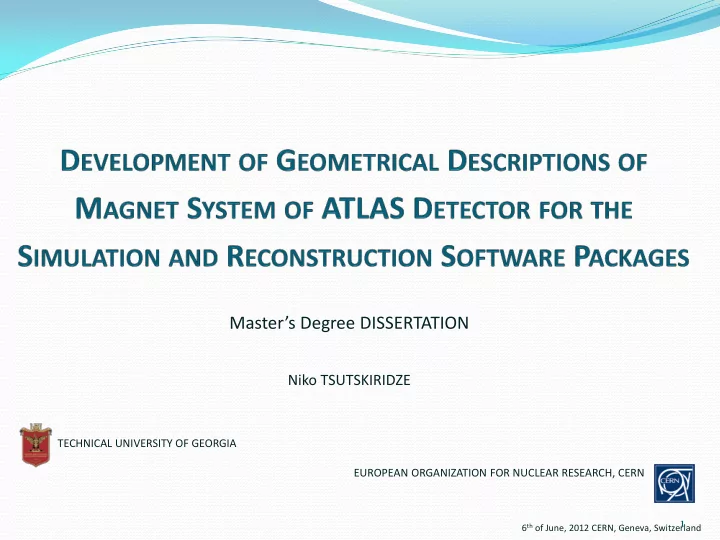

Master’s Degree DISSERTATION Niko TSUTSKIRIDZE TECHNICAL UNIVERSITY OF GEORGIA EUROPEAN ORGANIZATION FOR NUCLEAR RESEARCH, CERN 1 6 th of June, 2012 CERN, Geneva, Switzerland
High Energy Physics Research Investigation of Big Bang How matter was created Are there any extra dimensions Microscopic black holes 2
High Energy Physics Research LHC – Large Hadronic Collider, Geneva, Switzerland 10’000 Science and Engineers 100 Countries ITER – International Thermonuclear Experimental Reactor, Cadareche, France 33 Countries FAIR – Facility for Antiproton and Ion Research Darmstadt, Germany 11 Countries 3
ATLAS Detector Description Calorimeters Muon System Magnets Inner Detector 4
ATLAS Computing 5 Main Directions: Data Acquisition Data Storage Reconstruction Simulation Data Distribution 5
ATLAS Computing/Data Acquisition Input Stream: 23PByte/Sec Output Stream: 100MByte/Sec 6
ATLAS Computing/Data Storage Data Filtering in Trigger System Cool Tags DB 7
ATLAS Computing/Data Distribution GRID 8
Reconstruction and Simulation Generator Data Stream Simulation RDO Reconstruction Physics 9
Detector Structure in Geant4/C++ 10
Geant4/C++ Models Preparation New Method Forsee: Extraction of Models from Smarteam Engineering Database Import of Geant4/C++ models in CATIA Compare Analysis Modification of Component Geometry Geant4/C++ conflicts checking 11
Research Map of Dissertation 1. Reproduction of Coils Engineering Model in CATIA 2. Segmentation and Definition of Mass Properties 3. Compare Analysis of Engineering and GEANT4/C++ Models 4. Simplification of Geometry 5. Generation of Geant4/C++ Codes 12
Model Reproduction in CATIA Engineering Model of Coil has been extracted 1. from SmarTEAM database 2. After, model was reproduced in CATIA by adding data from 225 CDD Drawings Section of Coil Inner part Outer part 13
Segmentation and Definition of Mass Vol.1. Cryostat Top Vol.2, 4, 6, 8. Cryostat Corner 14
Segmentation and Definition of Mass Vol.3, 7. Cryostat Short Vol.5. Cryostat Bottom 15
Segmentation and Definition of Mass Vol.9. Voussoirs Vol.10. Steffeners 16
Segmentation and Definition of Mass Vol.11. Ribs Vol.12. Thermal Shielding 17
Segmentation and Definition of Mass Vol.13. Tie Rod Vol.14. Casing 18
Segmentation and Definition of Mass Vol.15. Casing Part Vol.16. Coils 19
Segmentation and Definition of Mass Vol.17. Services Vol.18. Service Support 20
Segmentation and Definition of Mass Vol.19. Fasteners 21
Segmentation and Definition of Mass Vol.20. Ribs of Thermal Shielding Vol.21. Ribs of Casing 22
Compare Analysis Reproduced Model Geant4/C++ Model VS ∆ 1 = Geant4/C++ - CATIA ∆ 2 = CATIA – Geant4/C++ = ∆ v1 + ∆ v2 + ∆ v3 + ∆ v4 + ∆ v5 + ∆ v6 + ∆ v7 + ∆ v8 = 0.124 m 3 – 0.001 m 3 + 0.176 m 3 + 0.198 m 3 – 0.157 m 3 + 0.088 m 3 ∆ v +0.149 m 3 + 2.327 m 3 = 2.9 m 3 = ∆ m1 + ∆ m2 + ∆ m3 + ∆ m4 + ∆ m5 + ∆ m6 + ∆ m7 + ∆ m8 = 1138 kg + 14 kg + 158 kg + 1738 kg – 911 kg + 778 kg + 1248 kg ∆ v + 7517.9 kg = 11 680.9 kg 23
Simplification of Geometry 2 Standard Phases of Synthesis: Grouping of components with same materials and density Unify groups with kindred materials and density 1 st Phase Volume 9.2 Volume 13.3 Simplification of Voussoirs Volume 9.1 Volume 13.2 Volume III 2 nd Phase Volume IV Volume V Discrepancies in Volume = 0.05 m 3 in Mass = 15Kg 24
Generation of Geant4/C++ Codes Geant4/C++ causes: Necessity for additional detalization of Geometry Programming in Z0 position Necessity in additional geometrical transactions for final positioning Creation of Overlaps and Gaps Gap 3 . 7 mm Overlap 2.83 mm 25
Generation of Geant4/C++ Codes Method for Geant4/C++ conflicts detection and evaluation in CATIA VP1 Converter 3D Max CATIA Component Component Disassembled Geant4/C++ Geometry Geometry Geometry Conflicts (.iv) (.Wrl) (.Wrl) 26
Generation of Geant4/C++ Codes Method for Geant4/C++ conflicts detection and evaluation in CATIA VP1 Converter CATIA Disassembled Disassembled Geant4/C++ Geometry Geometry Conflicts (.iv) (.Wrl) 27
Generation of Geant4/C++ Codes 1 2 3 4 According to Given Structure it was generated Geant4/C++ code for the full Coil Code consists of 235 programming strings 28
Conclusions 1. Creation of precise descriptions of ATLAS detector components on the base of engineering data is actual task for the Reconstruction and Simulation 2. Implementation of CATIA provides efficient way for the comparison of Geant4/C++ descriptions with Engineering models 3. Compare analysis should be done by CATIA DMU algorithms 4. Geometry export from Geant4/C++ to CATIA should be done on the base of facet representation of geometry ( .wrl file) 5. New method of visualisation and calculation of Geant4/C++ overlaps and Gaps on the base of CATIA, was developed 6. For the ATLAS detector Coils – New models reproduction, Compare analysis, Simplification and Geant4/C++ code generation have been done 29
Thank you for Attention 30
Recommend
More recommend